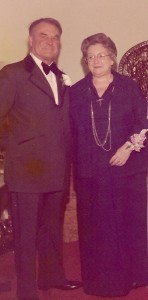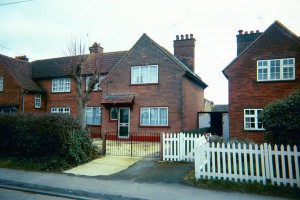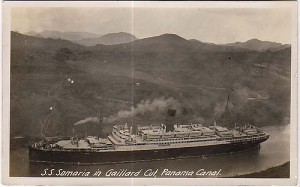On August 6, 1911, Herbert R. Cole was born in a small English fishing village called Burnham-on-Crouch, located about an hour-and-a-half east of London by train. He was a child during World War I, and worked in a local steel foundry while growing up between the wars. (I remember him bragging that he could pick up a piano frame with his teeth.) When World War II broke out, he joined the British Merchant Marine and ended up sailing to almost every corner of the world during the war.
This chronicle was originally compiled and written by my father, and sightly edited by me with some additional research.
29 November 1939 – 23 December 1939
S.S. Orontes
Liverpool, England to Sydney, Australia
Round trip via the Suez Canal and Ceylon
15 January 1940 – 16 April 1940
S.S. Orontes
Liverpool, England to Sydney, Australia
Round trip via the Suez Canal and Ceylon
18 May 1940 – ??
S.S. Orontes
Liverpool, England to Sydney, Australia
Round trip via the Suez Canal, West Africa, Cape Town, and Bombay
During these voyages, Granddad visted African villages in Kenya and South Africa. He often mentioned going into the dirt and thatch huts. He was also greatly impressed by the tremendous poverty in Bombay and the many beggars in the streets. Many were crippled and desperately thin. He talked of one particular beggar that dragged himself along the ground, wearing the skin off parts of his legs down to the bone. The young kids would gather around any Westerner and yell “mungie”, which was Hindi for food.
On one of his trips to Bombay, they unloaded chests of tea marked for Winston S. Churchill.
While in Port Said during one of these voyages, he was able to arrange a visit in Cairo with his brother Keith. Keith was stationed near Cairo with the Royal Air Force.
He was able to visit his cousins in Australia during one of these visits as well. He talked of the cold train ride over the Blue Mountains to their home, and their warm welcome to him.
15 October 1940 (Depart)
S.S. Samaria
Liverpool, England to New York City
Granddad traveled to New York as a passenger on the S.S. Samaria and then took a train from New York to Galveston, Texas to pick up the S.S. Labette. While in New York, he met Mary Hendrickson while eating apple pie at a Woolworth’s store. She was fresh out of high school and was living with her aunt and working at the American Bible Society. Throughout the war, they kept in touch and Granddad visited her when in New York.
While in Galveston, he had his photograph taken with a Texas longhorn bull.
18 April 1941 (Return)
S.S. Labette
Galveston, Texas to Liverpool, England
The S.S. Labette was in very poor condition and very slow. On this trip, it stopped in Halifax, Nova Scotia to pick up a convoy. Thirty-six hours out of Halifax on the voyage to Liverpool, it got stuck in a blizzard in the mine fields. It took six days to return to Halifax through the mine fields and blizzard, and when it finally got across the Atlantic, it took fourteen days for the crossing. The harbor master at Liverpool initially would not allow the Labette to enter the port, as it had been given up as lost. Granddad had his photograph taken on the deck of this ship. He is wearing a full beard and a duffel coat, and there is about six inches of ice all over the ship.
10 May 1941 – 9 September 1941
S.S. Brittany
Liverpool, England to Buenos Aires, Argentina
While in Buenos Aires, Granddad saw the wreck of the German pocket battleship, Admiral Graf Spee. She had been scuttled rather than surrender to the Royal Navy after a running gun battle had severely damaged it and they had entered Buenos Aires. As it was a neutral port, by law she had to leave the port in three days. Instead, they scuttled her.
Granddad had a love of banannas, and while in Beunos Aires he bought a whole stalk and ate them all. He developed a fungus on his tongue which turned the tongue black. It gradually peeled off.
The return trip was via Halifax, Nova Scotia.
Granddad stayed with the S.S. Reina del Pacifico from October 1941 to February 1943. The voyages were:
23 October 1941 – 23 November 1941
Liverpool, England to Halifax, Nova Scotia
Round trip
26 November 1941 – 16 March 1941
Liverpool, England to Bombay, India
Round trip via Cape Town, South Africa
3 April 1942 – 1 September 1942
Liverpool, England to Bombay, India
Round trip via Cape Town, South Africa
September 1942 – 10 February 1943
Liverpool, England to Arzew, Algeria
Liverpool, England to Oran, Algeria
Liverpool, England to Algiers, Algeria
The three round trips to Algeria were in the support of the North African invasion. During the trip to Arzew, he got a photograph of his brother Spencer’s ship being bracketed by bomb bursts on either side of the ship.
11 March 1943 – 3 April 1944
S.S. Queen Elizabeth
During this period, Granddad made eleven round trips between Gourock, Scotland and New York City, and one round trip between Gourock and Halifax. The Queen Elizabeth and the Queen Mary made the trans-Atlantic crossings without convoy or escort, depending instead on their great speed as the fastest trans-Atlantic liners of their time. This was due to an accident early in the war. The Queen Mary was being escorted off the coast of Ireland by the H.M.S. Curacoa, a light cruiser. They were doing the standard zig-zag alterations in course because of the German U-boat threat. The first night out of port, there was a mix-up in communications and the Curacoa was cut in half as she crossed the bow of the Queen Mary. 338 sailors were lost. It was decided that it was too risky to escort these two ships, and from that point until the end of the war, they left port at full steam and slowed only upon arrival at their destination.
During one of these high-speed runs while Granddad was on board, the Queen Elizabeth was struck by a rogue wave. It broke out the glass on the bridge and buckled fifty feet of the main deck of the bow.
12 September 1944 – 4 November 1944
S.S. Franconia
During this period, Granddad made three round trips between Liverpool and New York. During one of his port calls in New York while serving on either the Queen Elizabeth or the Franconia, Granddad was mugged and kicked in the jaw. This resulted in osteomyelitis of the right mandible, and the abscess was so large as to press against the trachia. It was drained by a ship’s surgeon and he was referred to Columbia-Presbyterian Hospital in New York for further surgery. The British government denied permission for the surgery to be done in New York, and Granddad returned to England. While in England he went to the Seaman’s Hospital, but it had been bombed and he was referred to Miller Hospital. After being in the hospital several days, he finally had the surgery.
1945
S.S. Franconia
On this trip, the Franconia transported Winston S. Churchill to Sevastapol, USSR for the Yalta Conference. While in Sevastapol, the English seamen were treated to a banquet. At the banquet, the seamen were seated with a male Soviet soldier on one side, and a female Soviet soldier on the other. There was much devastation in Sevastapol due to the fierce fighting that had taken place, and many of the buildings had been destroyed.
While on the return trip, they stopped in Taranto, Italy to offload Churchill and his official party. Earlier in the war, the Royal Navy had conducted an air raid on Taranto and sunk some Italian battleships. Taranto was a shallow harbor very similar to Pearl Harbor, and that attack was a model for the later attack by the Japanese on the American fleet at Pearl Harbor.
1945
R.M.S. Aquitania
Granddad made two round trips between Liverpool and New York during the last year of the war. At this time, Granddad had decided that after the war was over, he would bring Mary to England where they would get married. After the war, however, the economy of England was ruined and it was decided that he would come to the United States instead, and return to England later.
1947
R.M.S. Aquitania
The final sea voyage of Herbert R. Cole. He sailed from Liverpool and landed in Halifax instead of New York due to bad weather. He thus entered the United States via Canada. This caused a bit of trouble with the immigration personnel, but it was soon straightened out.
Shortly after his arrival in New York, carrying everything he owned in two large leather suitcases, he was married to Mary Hendrickson at Marble Collegiate Church (the same church where Norman Vincent Peale was pastor). Their honeymoon was the train ride from New York to Cincinnati.
 On December 3rd of that year, their first child and my father was born. Granddad got a job as a strikebreaker at Cincinnati Bell, despite being unable to legally work in the US at the time. At that point they lived in Bellevue, Kentucky, just across the Ohio River from Cincinnati. They would later move a short distance to Fort Thomas, which would become my hometown in 1975. By the time Granddad retired, he was responsible for all the underground phone lines in the city of Cincinnati. My fondest childhood memories usually involve family gatherings at my grandparents’ old house and playing around with my cousins in the back yard.
On December 3rd of that year, their first child and my father was born. Granddad got a job as a strikebreaker at Cincinnati Bell, despite being unable to legally work in the US at the time. At that point they lived in Bellevue, Kentucky, just across the Ohio River from Cincinnati. They would later move a short distance to Fort Thomas, which would become my hometown in 1975. By the time Granddad retired, he was responsible for all the underground phone lines in the city of Cincinnati. My fondest childhood memories usually involve family gatherings at my grandparents’ old house and playing around with my cousins in the back yard.
Eventually everybody in the family started going their separate ways, and my grandparents moved into a new condominium down the road in Southgate. My grandmother — the young woman Granddad met at Woolworth’s over apple pie — died of complications from diabetes in 1988. Granddad died of a rare form of cancer in July of 1993, survived by two sons, two daughters, and nine grandchildren. Doctors speculated that his cancer may have been related to his work in the steel foundry back in Burnham-on-Crouch.
I never got to tell you in person, granddad, but thanks.









